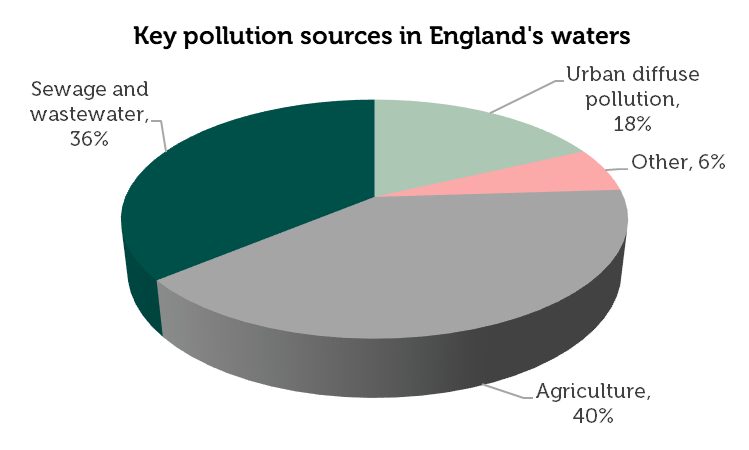Barely a week goes by without news of untreated sewage flowing into England’s rivers and seas, polluting important habitats, and risking the health of the people that enjoy them. No rivers, lakes, or coastal waters in England are free of pollution, and very few are in good ecological condition [1]. Outrage and calls for action from swimmers, surfers and the general public are becoming deafening.
How can investors address this problem?
First, we need to zoom out to understand the sources of pollution and why they happen.
Where is the pollution coming from?
The largest source of pollution in England’s waters is agricultural runoff – pesticides, fertilisers, animal waste and soils washed from farms and fields and into waterways. However, largely untreated sewage and wastewater releases are a close second.

Source: Environmental Audit Committee as at January 2022 [2]. The information shown above is for illustrative purposes.
This drives high nutrient concentrations, drawing oxygen from the water and undermining its ability to support life. Around a fifth of all pollution is washed into waterways from urban areas – including oils, microplastics, and litter. Together, these form a ‘chemical cocktail’ in our waters.[2]
The mix of pollution in any given water body will vary; agricultural runoff is likely to be dominant in rural areas, while sewage and urban runoff are often the key sources in and around built-up areas. Recent evidence suggests that sewage discharge has the greatest impact on water quality [3].
Why is it happening?
Despite steady improvements in recent decades, excess and relatively indiscriminate application of pesticides and fertilisers; intensive livestock and poultry farming; and poor slurry storage and application practices are the main drivers of agricultural pollution. In urban areas, vehicles are ultimately a key driver – from particles produced from brake and tyre wear, to oils, brake fluid and exhaust emissions dissolved into water.
Pollutants contained in agricultural and urban runoff are from ‘diffuse’ pollution sources – they are difficult to trace back to individual points of origin – and so are challenging to effectively prevent.
Pollution from sewage is different. Much of England is served by ‘combined’ sewer systems built in the 19th Century. Combined sewers collect waste from homes and businesses, but also rainwater. Both types of wastewater are transported through the same pipes to treatment plants, where water companies are required to make it safe before releasing it back into the environment.
At times of exceptionally heavy rainfall, water companies are allowed to open ‘overflows’ – pressure valves that allows partially untreated sewage into waterways, to prevent the system from becoming overloaded and backing up into homes and businesses. There are 15,000 of these overflows dotted around England [4].
These overflows were designed for use in exceptional circumstances. However, in 2022, more than 300,000 overflow spills occurred across the 90% of sites that are monitored. On average, c.15% of monitored overflows were open at any given time [5].
This reflects a long-term increase in both the number and duration of sewer overflow events. This is mainly because the system lacks the capacity to handle the waste created by a growing population and the expansion of impermeable urban surfaces from which rainwater rapidly drains. Investment in wastewater infrastructure has not kept pace with these growing challenges [6]. The data shows that pressures are now so great that overflows in some areas are being triggered at times of little to no rainfall [7].
Policy failures take much of the blame. Permits allow overflows only during ‘exceptional rainfall’, but don’t define the term, making it difficult to issue sanctions. They also require a minimum rate of sewage treatment even during overflow events, but in some cases, companies appear in breach of this condition [8] – the fines for which were capped at a relatively low rate until recently.
Companies are responsible for monitoring and reporting overflow events, but at low granularity, meaning that actual levels of overflow could be significantly higher than reported. Although the Environment Agency also monitors water bodies to test for pollution, it does this through a small number of random ‘spot’ samples that fail to capture the full picture.
How can the crisis be solved and what are the investment opportunities?
The Government must make sure that policy to tackle water pollution is ambitious, but also fit-for-purpose. This includes proper deterrents through to full enforcement of regulations and sanctions for breaches. It should also include robust and thorough monitoring to detect when breaches occur.
Technology for real-time and continuous monitoring of water quality is widely available and affordable. Sensors placed in and around water bodies, coupled with satellite monitoring and AI, could provide farmers, water companies, regulators and the public with highly detailed information on the wider watershed.
Global market leaders in wastewater treatment such as Veolia offer smart monitoring solutions that can reduce the risk of leaks and increase uptime in the treatment of wastewater. Their scale and breadth of experience supports their progress in leveraging AI for the real time management of water and wastewater. This is a market expected to continue growing for many decades, through retrofitting of existing systems and deployment in new, smart cities.
Technology can also allow for real-time monitoring of sewage systems and treatment facilities, drive optimal performance and alert operators to any current or likely future risks that may inhibit it (such as growing ‘fatbergs’). For instance, UK-listed Halma recently launched SpillSens, a digital positioning sensor which acts as an early warning system for sewer blockages and overflows. Severn Trent has so far deployed 1600 of its sensors in problem areas of the Midlands, enabling cleaning crews to remove blockages before pollution events occur [9].
‘Sustainable Drainage Systems’ (SuDS) aim to mimic natural drainage systems, particularly in urban areas, by intercepting the flow of water to drains and sewers through temporary storage in filter trenches and ponds, and subsequent release to water bodies through infiltration trenches, soakaways or wetlands. SuDs act as both a direct water treatment and flood protection system, while also reducing pressure on combined sewer systems – avoiding the need for disruptive and expensive repairs. SuDs are soon to be mandatory for all new developments in England but are sorely lacking across most of the country [10]
Following the devasting floods which hit Leeds on Boxing Day in 2015, Leeds City Council has adopted a new approach to flood protection across its catchment area. Arcadis is working with Leeds City Council on the ‘Leeds Flood Alleviation – Natural Flood Management project’ [11]. As a world leading engineering and sustainable design consultancy, Arcadis has brought its skillset to develop a combination of traditional engineered defences and nature-based solutions to enhance flood protection across the region. The need for a forward thinking and ambitious approach to flood management will continue to increase as a result of our exposure to extreme weather events.
A rising amount of capital is being allocated to mitigating these issues. In October 2023, UK water companies revealed plans to invest £96bn from 2025-2030 in water and sewage infrastructure – nearly double the £51bn commitment for the prior 5-year period. The plans cover construction of new reservoirs, initiatives to cut leakages by more than 25% and reduction of overflow spills as a result of what is expected to be the most ambitious modernisation of sewers since the Victorian era [12]. Further, central government has been progressively increasing its Flood and Coastal Erosion Risk Management (FCERM) expenditure – it has historically contributed 90% of funding [13].

Source: Department for Environment Food & Rural Affairs [13]. The information shown above is for illustrative purposes.
Action to tackle the root causes of water pollution is also important. For example, harnessing precision agriculture to target the application of fertilisers and pesticides when and where they are most needed, and avoiding times when poor weather conditions may increase the risk of runoff [14]. Leveraging natural ecosystems, engineering and water chemistry to divert and treat water polluted by abandoned mines can limit the ongoing contamination of rivers by metal-rich sediment [15].
This is one of the many areas in which the water tech expertise of Xylem can contribute to the challenge of cleaning up our waterways. With a comprehensive portfolio of technology, it is able to design and implement a process tailored to the specific challenges of any given site, offering a reliable and cost-effective solution to its customers. This differentiated approach positions the business well for the growing demand for change.
Whilst the remediation of existing pollution to our waterways will be slow and challenging, we have many proven solutions which can mitigate further damage. The pressure is growing for polluters to adopt better practices, encouraging them to procure specialist services. This presents a significant opportunity for businesses which offer water testing and monitoring; wastewater treatment; and precision and digital agriculture solutions – as well as for investors – with many of these technologies represented in the Redwheel Clean Economy and Biodiversity Strategies.
[2] https://publications.parliament.uk/pa/cm5802/cmselect/cmenvaud/74/report.html#heading-1
[3] https://www.ox.ac.uk/news/2023-09-22-new-study-finds-sewage-release-worse-rivers-agriculture
[4] https://publications.parliament.uk/pa/cm5802/cmselect/cmenvaud/74/report.html#heading-3
[6] https://publications.parliament.uk/pa/ld5803/ldselect/ldindreg/166/16603.htm
[7] https://publications.parliament.uk/pa/cm5802/cmselect/cmenvaud/74/report.html#heading-3
[8] https://www.theguardian.com/environment/2023/oct/19/welsh-water-admits-spilling-untreated-sewage-near-dolphin-habitat-for-decade https://publications.parliament.uk/pa/cm5802/cmselect/cmenvaud/74/report.html#heading-3
[9] Protecting water through digital technologies – Halma plc
[10] Get set for SuDS in England | Hydrock
[11] Leeds, UK flood alleviation | Arcadis
[14] https://researchbriefings.files.parliament.uk/documents/POST-PN-0505/POST-PN-0505.pdf
Key Information
No investment strategy or risk management technique can guarantee returns or eliminate risks in any market environment. Past performance is not a guide to future results. The prices of investments and income from them may fall as well as rise and an investor’s investment is subject to potential loss, in whole or in part. Forecasts and estimates are based upon subjective assumptions about circumstances and events that may not yet have taken place and may never do so. The statements and opinions expressed in this article are those of the author as of the date of publication, and do not necessarily represent the view of Redwheel. This article does not constitute investment advice and the information shown is for illustrative purposes only.

